When Is a Tracheal Occlusion Installed for Cdh Babies
- Techniques and Instrumentation
- Open Admission
- Published:
Fetoscopic endoluminal tracheal apoplexy and reestablishment of fetal airways for congenital diaphragmatic hernia
Gynecological Surgery volume 15, Article number:9 (2018) Cite this article
Abstract
Background
Congenital diaphragmatic hernia (CDH) is a congenital anomaly with high mortality and morbidity mainly due to pulmonary hypoplasia and hypertension. Temporary fetal tracheal occlusion to promote prenatal lung growth may ameliorate survival. Entrapment of lung fluid stretches the airways, leading to lung growth.
Methods
Fetal endoluminal tracheal occlusion (FETO) is performed by percutaneous sono-endoscopic insertion of a balloon developed for interventional radiology. Reversal of the occlusion to induce lung maturation can be performed by fetoscopy, transabdominal puncture, tracheoscopy, or by postnatal removal if all else fails.
Results
FETO and balloon removal accept been shown safety in experienced easily. This paper deals with the technical aspects of airship insertion and removal. While FETO is invasive, it has minimal maternal risks yet can cause preterm nativity potentially offsetting its beneficial effects.
Conclusion
For left-sided severe and moderate CDH, the process is considered investigational and is currently being evaluated in a global randomized clinical trial (https://www.totaltrial.eu/). The process can exist clinically offered to fetuses with severe correct-sided CDH.
Background
Congenital diaphragmatic hernia (CDH) is a life-threatening condition affecting upwards to 3 in 10,000 live built-in babies [1]. The diaphragmatic defect allows abdominal organs to herniate into the thorax which prevents normal lung development. Depending on the side and size of the defect, this may be the liver, bowel, spleen, and/or breadbasket. The majority of defects are left sided (LCDH 85%). Thirteen percentage are right sided (RCDH), and bilateral defects or other forms occur very rarely. Associated anomalies are frequent and should exist ruled out past imaging and genetic testing as they independently influence survival and morbidity. In about registries currently, survival is approximately lxx% depending on the case mix and location of treatment [2]. Surviving patients may suffer from not only medium and long-term morbidity predominantly respiratory in nature, but also gastro-esophageal reflux, failure to thrive, and less common orthopedic or other issues.
Individualized prognosis of isolated CDH can exist fabricated prenatally past using the lung size, the presence of the liver in the thorax, and the side of the defect [3]. Patients with predicted poor prognosis can be offered experimental fetal therapy. To meliorate survival, the intervention should reverse pulmonary hypoplasia (i.eastward., stimulate lung growth) before birth. Historically, this was attempted by anatomical repair of the defect in utero. The results of this arroyo were suboptimal [iv]. Besides, the anatomic defect itself can be relatively hands managed afterward birth hence it is not the problem. An alternative strategy, based on the clinical observation that fetuses with laryngeal atresia have larger lungs, led to animal experiments that demonstrated that fetal tracheal occlusion reverses experimental pulmonary hypoplasia [5]. Tracheal occlusion leads to accumulation of lung fluid which in turn causes lung stretch. This activates a pathway that leads to proliferation and increased growth of the airways and pulmonary vessels, nicely summarized in the acronym PLUG: "Plug the Lung Until information technology Grows" (PLUG) [half-dozen]. Nonetheless, when the occlusion is maintained until nativity, the number of blazon II pneumocytes is abnormally low, leading to a relative surfactant deficiency [seven]. By reversing the tracheal apoplexy before birth, the residuum between type I and type II pneumocytes at birth is more optimal. This is captured in the concept "plug-unplug sequence," and reversal of occlusion is an important component in the fetal handling strategy [seven]. Nowadays, tracheal occlusion is uniquely performed by minimally invasive fetal endoluminal tracheal apoplexy (FETO) and performed under sono-endoscopic guidance. This is a percutaneous procedure in which a latex balloon is endoscopically positioned to a higher place the carina and inflated to occlude the trachea [8] (Fig. 1). The present paper describes the instrumentation and the technical aspects of the FETO procedure as currently performed by the in a higher place clinical enquiry consortium inside their clinical trial.
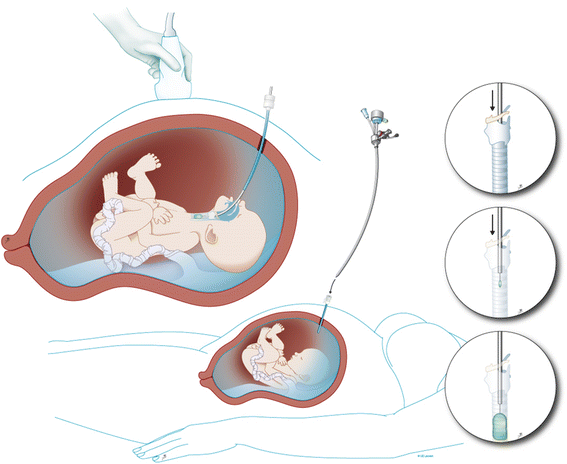
Fetal endoscopic tracheal occlusion (FETO): a schematic cartoon showing access to uterus and the fetal trachea. Inserts: steps in balloon delivery. © UZ Leuven, UZ Leuven, Belgium, drawing Myrthe Boymans
Methods
Selection of fetuses
CDH is typically diagnosed during mid-gestation on screening ultrasound. Post-obit the diagnosis (or suspicion thereof), patients are all-time referred to a 3rd heart where this condition is routinely managed subsequently birth. Patients will exist reassessed with targeted ultrasound and magnetic resonance imaging (MRI) and will be offered genetic testing (today this is by micro-array assay) [nine]. This has two purposes, (1) to rule out associated structural or genetic anomalies, which themselves may worsen the prognosis dramatically and (2) to assess the severity of the pulmonary hypoplasia. This information is used to make a personalized prognosis and lead multidisciplinary counseling. Additional evaluation frequently reveals some elements of discordance with the initial assessment at the referring site and may well upshot in a changed perspective and dissimilar parental decisions [10]. Therefore, information technology is considered prudent to limit prognostic advice at first diagnosis.
In isolated cases, personalized prediction of outcome is based on measurements of lung size, liver position, and the side of the defect [eleven]. Although other characteristics are being investigated amongst which stomach position, pulmonary circulatory parameters, and cardiac ventricular size every bit additional prognostic indicators, the lung-to-caput-ratio (LHR) remains the best studied parameter for prediction. The lung contralateral to the lesion is measured in the standard aeroplane for a four-bedchamber view of the eye, and the head circumference is measured in a standard biparietal view (Fig. 2a, b) [12]. The nearly authentic way of measuring the lung is by tracing its outline [13]. The LHR measured in the index example (observed) is expressed as a percent (o/due east LHR; %) of what one would expect in a normal fetus at a similar gestational age (expected). MRI is now well-nigh ubiquitously used in tertiary centers for evaluation of congenital anomalies. In CDH cases, MRI allows for volumetric measurement of both lungs, the power to quantitate the degree of liver herniation, and a detailed assessment of tum position. And so far, fetal MRI lung volumetry in CDH does non provide improved outcome prediction over ultrasound; hence, we do non use information technology for decisions regarding FETO. The predictive value of imaging methods in terms of pulmonary hypertension or extra-corporeal membrane oxygenation needs is currently under review [14].
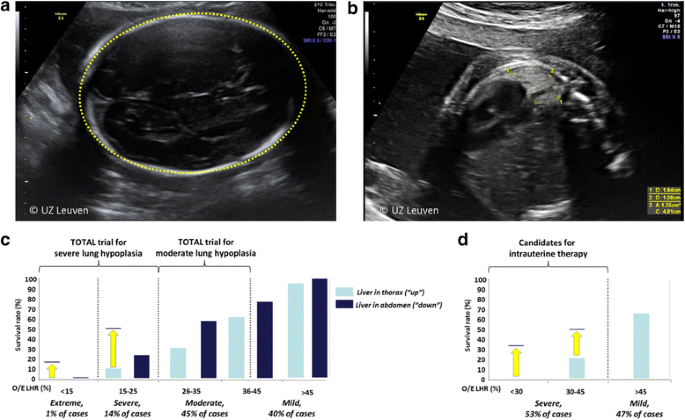
The o/e LHR is calculated by taking the ratio of the lung area divided by the caput circumference, compared to a reference value for that gestational age. a Caput circumference. b Lung area and diameter measured in the plane of the four-bedroom view, the lung is posterior to the heart. c Survival rates of fetuses with left-sided CDH expectantly managed during pregnancy, as a function of unlike o/e LHR and liver position. d Same, for fetuses with right-sided CDH. Yellow arrows point improved survival after FETO as reported by Jani et al. 2006 (left CDH) and DeKoninck et al. 2022 (right CDH) [11, 26]. Adapted, with permission, from Russo et al. 2022 [27]
Fetuses from singleton pregnancies with a predicted poor postnatal outcome are the target grouping for fetal intervention. The o/east LHR, presence of the liver in the thorax, and the side of the defect are used so stratify these fetuses [15] (Fig. 2c, d). Babies born across 30 weeks with a left-sided CDH, a herniated liver, and an o/e LHR < 25% who are managed with standard post-natal therapy accept a survival charge per unit that is < 20% [11]. These parameters were therefore used to define that group of fetuses with astringent pulmonary hypoplasia, and they formed the initial study population for prenatal therapy. Despite encouraging early feel with FETO [xvi], fetal surgery for isolated CDH is nonetheless considered experimental. Patients with a fetus who has an isolated LCDH and severe lung hypoplasia are currently beingness offered participation in a global randomized clinical trial (https://www.totaltrial.eu/) comparing outcomes of FETO to expectant management during pregnancy, followed by standardized postnatal therapy [17]. In a second experimental arm to this trial, patients with a CDH fetus with moderate pulmonary hypoplasia (which has a l% or greater survival rate) are randomized to FETO or expectant management, in an effort to reduce oxygen dependency at half-dozen months of historic period. For RCDH, fetal therapy is offered in case of severe hypoplasia (o/e LHR < 45%) because they have a predicted survival charge per unit of 17%. For patients who accept a more complex presentation with boosted findings, a more individualized approach can be taken, all the same in the absence of proof of benefit, this is debatable[eighteen, xix].
FETO or PLUG procedure
FETO was initially performed at 24–28 weeks merely in cases of severe CDH and under epidural anesthesia. Today, the procedure is typically performed under local anesthesia at 27–29 weeks with conscious sedation optional, yet loco-regional tin can be done when clinically required. In moderate cases, FETO is done at 30–32 weeks. We utilise safe tocolysis (atosiban or alternatively indomethacin or nifedipine) and antibiotics (cefazolin 2 g i.five. 8 hourly) until 24 h after the process. The patient is positioned in a dorsal supine position (with lateral tilt to prevent caval compression) such that in that location is straight access to the fetal rima oris. External fetal manipulation may be required. Once in the appropriate position, we administer pancuronium (0.2 mg/kg) or equivalent, atropine (xx μg/kg), and fentanyl (fifteen μg/kg) intra-muscularly through a 22 Chiliad needle to the fetus to provide analgesia, immobilization, and prophylaxis against bradycardia. Later sterile draping, the insertion trajectory is infiltrated with local anesthesia (lidocaine 1% 10–20 mL). A skin-incision is made and a disposable flexible 10 Fr cannula (iii.3 mm; RCF 10.0 Check-Flo Performer, Melt, Bloomington, IN) loaded with a pyramidal trocar (11650TG, Karl Storz, Tutlingen, Germany) is inserted into the amniotic cavity under ultrasound guidance, in an area devoid of placenta and as perpendicular as possible to the nose tip (Additional file one: Video S1; Fig. 3). Some introduce the cannula using the Seldinger technique [twenty].
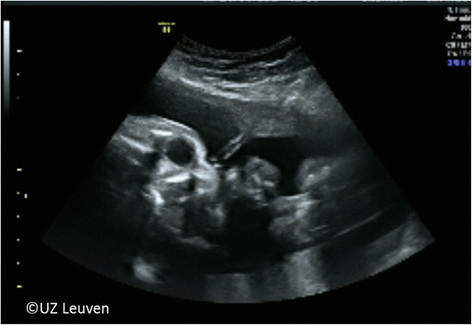
Transabdominal trocar entry in the direction of the tip of the olfactory organ. © UZ Leuven, UZ Leuven, Kingdom of belgium
Boosted file 1: Video S1. The trocar is inserted into the amniotic crenel under ultrasound guidance, in an expanse devoid of placenta and as perpendicular equally possible to the nose tip. Copyright: UZ Leuven, Leuven, Belgium. (MP4 4355 kb)
The fetoscope is a 1.three-mm cobweb optic endoscope (11540AA, Karl Storz) housed within a curved 3.three-mm sheath (11540KE; Karl Storz) with a commitment catheter (Baltacci-BDPE-100 0.9 mm; Balt, Montmorency, France) that is loaded with a detachable inflatable latex airship with integrated one-way valve (Goldbal2). These are used "off-label" as they were originally designed for endovascular occlusion. The inflated airship accommodates for an increasing tracheal diameter during pregnancy. A stylet (11506P; Karl Storz) and grasping forceps (11510C, Karl Storz) are available to puncture and remove the balloon should it be incorrectly positioned (Fig. 4). We flush warmed crystalloid (Hartmann's solution or Ringer's Lactate) through the fetoscope sheath in order to distend the larynx, clear the debris, and improve vision.

Fetoscope, fetoscopic forceps, and stylet, courtesy of KARL STORZ Endoskope, Tuttlingen, Germany
Landmarks for airship insertion are progressively the tip of the nose, philtrum, tongue, the raphe of the palate, uvula, epiglottis, and ultimately the song cords (Additional file 2: Video S2; Fig. 5). The fetoscope is advanced into the trachea until the carina is visualized, or if that is not possible, at least to a point where the tracheal rings and pars membranacea tin be positively identified. The balloon is then advanced out of the fetoscope, positioned between the cords and the carina, and inflated with 0.half-dozen mL of isotonic saline. Once inflated, the balloon is detached (Additional file three: Video S3; Fig. 6a). Finally, excessive amniotic or irrigation fluid is drained until a normal book is achieved. In our initial experience, the median duration of FETO was 10 min (range 3–93 min). Operating time depends mainly on operator experience and on the position of the fetus and is directly related to the risk of chorionic membrane separation and amniorrhexis.
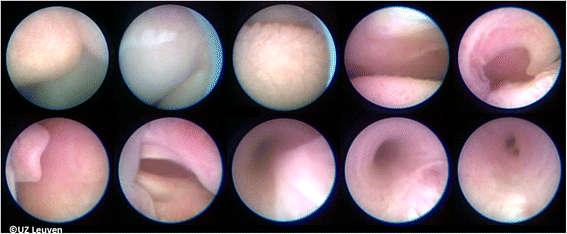
Landmarks used for guidance from the tip of the nose to trachea. Up from left to right: tip of olfactory organ, upper lip, tongue, raphe palate, and uvula. Down from left to right: epiglottis, vocal cords, trachea with inwards bulging pars membranacea, trachea more expanded and also better visualization of the tracheal rings, and carina. © UZ Leuven, UZ Leuven, Belgium
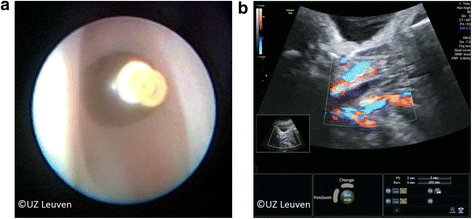
a After detachment the airship can be seen through the song cords which are in this example just in a higher place it. b On ultrasound the balloon is visible every bit a hypoechogenic surface area. Power Doppler can aid to distinguish the balloon from the adjacent claret vessels. © UZ Leuven, UZ Leuven, Belgium
Additional file 2: Video S2. The subsequent landmarks are seen as the fetoscope is avant-garde to the fetal trachea. Chronologically: lower lip, tongue, uvula, soft palate, epiglottis, song cords, and tracheal pars membranacea. Copyright: UZ Leuven, Leuven, Kingdom of belgium. (AVI 4860 kb)
Boosted file 3: Video S3. The balloon is inflated with 0.6 mL of isotonic saline solution and fills the trachea just distal to the cords, post-obit which it is discrete. Copyright: UZ Leuven, Leuven, Belgium. (AVI 6806 kb)
Follow-up
Patients are followed with ultrasound every 1 to 2 weeks until the preset fourth dimension for reversal of the apoplexy. The fetus is evaluated for growth, motility, general wellbeing and routine antenatal care, and the cervical length is measured to estimate the risk for preterm nascency. Amniotic fluid book is measured to exclude polyhydramnios as this is common in CDH and tin can increase the risk of amniorrhexis and/or preterm labor. Amniodrainage is performed when the deepest vertical pool exceeds 12 cm. The membranes are inspected for amnion-chorion membrane separation. At each visit, the balloon is visualized since spontaneous deflation has been described [21]. The tracheal balloon appears on ultrasound as a hypoechoic fluid-filled construction without colour Doppler menses and positioned just beneath the vocal cords between the common carotid arteries (Fig. 6b). Within a calendar week post-obit FETO, the fetal lung in responders becomes hyperechogenic. The parenchymal dimensional changes are quantified via the o/e LHR or MRI. Book changes precede the vascular response. In case of amniorrhexis or preterm labor, the patients are admitted and management is individually planned for timely and safe airship removal. Chorioamnionitis is the most common complication of membrane rupture and may mandate balloon removal and delivery. Antepartum hemorrhage has been described even so is in our experience uncommon [21].
UNPLUG or balloon removal
Our policy is to remove the balloon in utero even if delivery is imminent. It triggers lung maturation, increases survival chances, reduces morbidity [22, 23], and permits vaginal delivery. Removal of the balloon is scheduled at 34 weeks gestational historic period based on observations in sheep. In 28% of cases, balloon removal will exist indicated earlier because of impending delivery [23]. Steroids are given to enhance lung maturation. The removal takes place in essentially the same preparation as described in a higher place for balloon placement, with the aforementioned fetal and maternal medications. The balloon can exist punctured straight using a 20-22G needle under ultrasound guidance and in our experience is expulsed spontaneously. (Boosted file 4: Video S4). In such cases, tracheal patency can be confirmed by sit-in of tracheal fluid motility with Doppler (Additional file 5: Video S5), change in tracheal diameter, or by MRI. The balloon can also exist fetoscopically removed, which provides straight visualization of unobstructed airways (Additional file vi: Video S6). In the event that fetoscopic in utero removal is not possible, we resort to tracheoscopic removal (Table 1 for instruments) with the baby on placental apportionment under loco-regional anesthesia (Fig. 7 and Additional file seven: Video S7). The fetal head and shoulders are delivered and straight laryngo-tracheoscopy is performed. In the worst (and not desirable) scenario, postnatal puncture from above the manubrium sterni is used, with or without ultrasound guidance, or by tracheoscopy. In a report on 302 cases, 67% of airship removals were past fetoscopy, 21% by puncture, and 10% past tracheoscopy on placental circulation, and 1% ex utero [23]. In that written report, the technique used appeared to be dictated mainly by operator preference. In that location was no deviation in gestational age at delivery whether the balloon was punctured or removed by fetoscopy. The importance of immediate availability of trained and experienced operators who tin remove a FETO balloon chop-chop and safely cannot, and must non, be underestimated. To our knowledge, the just neonatal deaths directly due to balloon removal difficulties that have occurred happened when delivery took place in an unprepared and/or inexperienced environs [23].
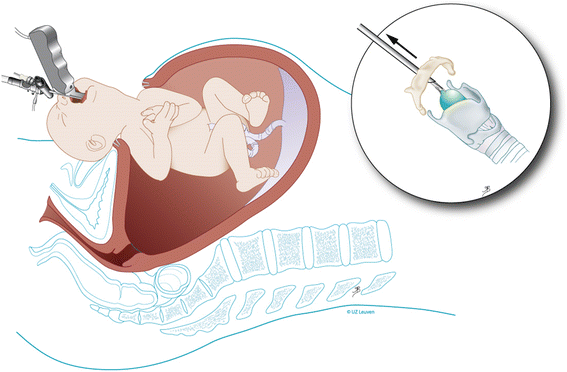
Schematic drawing of tracheoscopic removal on placental circulation under loco-regional anesthesia. © UZ Leuven, UZ Leuven, Belgium, cartoon Myrthe Boymans
Boosted file four: Video S4. The balloon is punctured under ultrasound guidance using a 20–22 1000 needle. The needle is inserted every bit shut equally possible to the anterior shoulder, which enables to pass the umbilical cord which is lying on the neck. Every bit the airship is punctured, the trachea can be seen collapsing. Copyright: UZ Leuven, Leuven, Kingdom of belgium. (MP4 5472 kb)
Additional file 5: Video S5. After puncturing, the balloon tracheal patency can be confirmed by demonstration free tracheal fluid movement with Doppler. Copyright: UZ Leuven, Leuven, Belgium. (MP4 3849 kb)
Additional file 6: Video S6. Fetoscopic unplugging provides direct documentation of free airways. As the lung fluid egresses, the pressure drops and the trachea volition slightly plummet. Copyright: UZ Leuven, Leuven, Belgium. (AVI 2303 kb)
Boosted file seven: Video S7. If not possible to puncture the balloon ultrasound guided or fetoscopic guided, we tin can resort to tracheoscopic removal on placental circulation under loco-regional anesthesia. Copyright: UZ Leuven, Leuven, Belgium. (MP4 6707 kb)
Reported adverse events and side effects with FETO are rare. Fetal tracheomegaly is a recognized entity that usually presents as a barking cough on endeavor and and so resolves over time with minimal long-term implications. At that place are a few neonates who accept had significant long-term tracheal problems, and these announced to have been related to traumatic balloon removal or early on insertion < 26 weeks [24]. This is however an aspect that requires more detailed and long-term follow-up. The main maternal-fetal complication is that of chorionic membrane separation and PPROM with resultant preterm nascence. Although the median gestational historic period at birth is 35 weeks, upwardly to one in three patients deliver prior to 34 weeks, potentially offsetting the effect of the fetal intervention.
Results
To engagement, the published data are predominantly based on observational trials and small case series [eight]. At that place is one randomized controlled trial [25, 26] that showed benefit of FETO; however, in that study all deliveries were by EXIT procedure, there was a case mix of right and left CDH, and the methodology was substantially unlike to what is currently beingness practiced in Europe and the USA.
Compared to historical controls of similar severity, FETO increases survival rate from 24 to 49% in LCDH with o/eLHR < 25% and from 17 to 42% in RCDH with o/eLHR < 45% [21, 26] (Fig. 2c, d). FETO also seems to reduce early on neonatal respiratory morbidity.
Give-and-take
This potential do good is now being investigated in two parallel randomized clinical trials (RCT) "Tracheal Apoplexy To Advance Lung growth" (https://www.totaltrial.eu/), in fetuses with LCDH and either severe or moderate lung hypoplasia (NCT01240057 and NCT00763737). Electric current fetal treatment centers are in Leuven, Kingdom of belgium; Paris, France; London, UK; Barcelona, Spain; Milan and Rome, Italy; Bonn, Germany; Toronto, Canada; Brisbane, Australia; and Houston, Texas, U.s.. These centers have a high volume fetoscopy program, completed a minimum learning bend of xv FETO procedures, and committed to strict adherence to a prenatal and postnatal direction protocol. The trial has recruited at the time of writing over 165 (moderate) and over 50 (severe) patients. Results are expected within the next 2 years at the electric current recruitment rate (moderate). We anticipate that more centers in the U.s. and in Nihon will exist joining the task strength which may accelerate recruitment.
Conclusions
FETO may modify the natural history of built diaphragmatic hernia, and early clinical results await promising. Information technology is hoped that the ongoing TOTAL trial will upshot in proof of do good. FETO is an invasive technique associated with a significantly increased risk for preterm birth which potentially tempers its benefits. The procedure requires specific skills and instrumentation and permanent services and is at present express to a select group of centers. If proven effective, this procedure is likely to be implemented more widely and appropriate dissemination will require an extensive preparation program and careful oversight in order to ensure safe implementation.
Abbreviations
- CDH :
-
Congenital diaphragmatic hernia
- EXIT:
-
Ex utero intrapartum treatment
- FETO :
-
Fetal endoluminal tracheal apoplexy
- LCDH:
-
Left-sided congenital diaphragmatic hernia
- LHR:
-
Lung-to-head-ratio
- MRI :
-
Magnetic resonance imaging
- o/eastward LHR:
-
Observed to expected lung-to-head-ratio
- PLUG:
-
Plug the Lung Until it Grows
- PPROM:
-
Preterm and Prelabor Rupture Of Membranes
- RCDH:
-
Right-sided congenital diaphragmatic hernia
- RCT :
-
Randomized clinical trial
- Full:
-
Tracheal Apoplexy To Advance Lung growth
References
-
EUROCAT. EUROCAT statistical monitoring report – 2012
-
Harting MT, Lally KP (2014) The built diaphragmatic hernia study group registry update. Semin Fetal Neonatal Med nineteen:370–375
-
Claus F, Sandaite I, Dekoninck P, Moreno O, Cruz Martinez R, Van Mieghem T, Gucciardo L, Richter J, Michielsen K, Decraene J, Devlieger R, Gratacos E, Deprest JA (2011) Prenatal anatomical imaging in fetuses with congenital diaphragmatic hernia. Fetal Diagn Ther 29:88–100
-
Harrison MR, Langer JC, Adzick NS, Golbus MS, Filly RA, Anderson RL, Rosen MA, Callen Pow, Goldstein RB, de Lorimier AA (1990) Correction of congenital diaphragmatic hernia in utero, V. Initial clinical experience. J Pediatr Surg 25:47–55 discussion 56-7
-
Wilson JM, DiFiore JW, Peters CA (1993) Experimental fetal tracheal ligation prevents the pulmonary hypoplasia associated with fetal nephrectomy: possible awarding for congenital diaphragmatic hernia. J Pediatr Surg 28:1433–1439 discussion 1439-40
-
Hedrick MH, Estes JM, Sullivan KM, Bealer JF, Kitterman JA, Scrap AW, Adzick NS, Harrison MR (1994) Plug the lung until it grows (PLUG): a new method to treat congenital diaphragmatic hernia in utero. J Pediatr Surg 29:612–617
-
Flageole H, Evrard VA, Piedboeuf B, Laberge JM, Lerut TE, Deprest JA (1998) The plug-unplug sequence: an important step to achieve type II pneumocyte maturation in the fetal lamb model. J Pediatr Surg 33:299–303
-
Deprest J, Gratacos E, Nicolaides KH, Group FT (2004) Fetoscopic tracheal occlusion (FETO) for severe built diaphragmatic hernia: evolution of a technique and preliminary results. Ultrasound Obstet Gynecol 24:121–126
-
Brady PD, Delle Chiaie B, Christenhusz M, Dierickx G, Van Den Bogaert K, Menten B, Janssens S, Defoort P, Roets E, Sleurs E, Keymolen Thou, De Catte L, Deprest J, de Ravel T, Van Esch H, Fryns JP, Devriendt K, Vermeesch JR (2014) A prospective study of the clinical utility of prenatal chromosomal microarray analysis in fetuses with ultrasound abnormalities and an exploration of a framework for reporting unclassified variants and adventure factors. Genet Med 16:469–476
-
Done E, Gucciardo L, Van Mieghem T, Devriendt K, Allegaert Chiliad, Brady P, Devlieger R, De Catte Fifty, Lewi L, Deprest J (2017) Clinically relevant discordances identified after tertiary reassessment of fetuses with isolated congenital diaphragmatic hernia. Prenat Diagn 37:883–888
-
Jani J, Nicolaides KH, Keller RL, Benachi A, Peralta CF, Favre R, Moreno O, Tibboel D, Lipitz S, Eggink A, Vaast P, Allegaert K, Harrison Grand, Deprest J, Antenatal CDHRG (2007) Observed to expected lung surface area to head circumference ratio in the prediction of survival in fetuses with isolated diaphragmatic hernia. Ultrasound Obstet Gynecol 30:67–71
-
Deprest JA, Flemmer AW, Gratacos Due east, Nicolaides Yard (2009) Antenatal prediction of lung volume and in-utero treatment by fetal endoscopic tracheal apoplexy in severe isolated built diaphragmatic hernia. Semin Fetal Neonatal Med xiv:eight–13
-
Jani J, Peralta CF, Benachi A, Deprest J, Nicolaides KH (2007) Assessment of lung expanse in fetuses with congenital diaphragmatic hernia. Ultrasound Obstet Gynecol 30:72–76
-
Russo FM, Eastwood MP, Keijzer R, Al-Maary J, Toelen J, Mieghem TV, Deprest JA (2016) Lung size and liver herniation predict the need for actress corporeal membrane oxygenation only not pulmonary hypertension in isolated congenital diaphragmatic hernia: a systematic review and meta-assay. Ultrasound Obstet Gynecol, 2017. 49(6):704–13.
-
Metkus AP, Filly RA, Stringer Md, Harrison MR, Adzick NS (1996) Sonographic predictors of survival in fetal diaphragmatic hernia. J Pediatr Surg 31:148–151 discussion 151-2
-
Al-Maary J, Eastwood MP, Russo FM, Deprest JA, Keijzer R (2016) Fetal tracheal occlusion for astringent pulmonary hypoplasia in isolated congenital diaphragmatic hernia: a systematic review and meta-analysis of survival. Ann Surg 264:929–933
-
Deprest J, Brady P, Nicolaides Thou, Benachi A, Berg C, Vermeesch J, Gardener G, Gratacos East (2014) Prenatal management of the fetus with isolated built diaphragmatic hernia in the era of the TOTAL trial. Semin Fetal Neonatal Med 19:338–348
-
Seravalli V, Jelin EB, Miller JL, Tekes A, Vricella 50, Baschat AA (2017) Fetoscopic tracheal occlusion for treatment of non-isolated congenital diaphragmatic hernia. Prenat Diagn 37:1046–1049
-
Van Mieghem T, Cruz-Martinez R, Allegaert K, Dekoninck P, Castanon M, Sandaite I, Claus F, Devlieger R, Gratacos E, Deprest J (2012) Consequence of fetuses with congenital diaphragmatic hernia and associated intrafetal fluid effusions managed in the era of fetal surgery. Ultrasound Obstet Gynecol 39:50–55
-
Deprest JA, Van Schoubroeck D, Van Ballaer PP, Flageole H, Van Assche FA, Vandenberghe K (1998) Alternative technique for Nd: YAG laser coagulation in twin-to-twin transfusion syndrome with anterior placenta. Ultrasound Obstet Gynecol 11:347–352
-
Jani JC, Nicolaides KH, Gratacos E, Valencia CM, Washed East, Martinez JM, Gucciardo Fifty, Cruz R, Deprest JA (2009) Severe diaphragmatic hernia treated by fetal endoscopic tracheal apoplexy. Ultrasound Obstet Gynecol 34:304–310
-
Done Eastward, Gratacos E, Nicolaides KH, Allegaert K, Valencia C, Castanon K, Martinez JM, Jani J, Van Mieghem T, Greenough A, Gomez O, Lewi P, Deprest J (2013) Predictors of neonatal morbidity in fetuses with severe isolated congenital diaphragmatic hernia undergoing fetoscopic tracheal occlusion. Ultrasound Obstet Gynecol 42:77–83
-
Jimenez JA, Eixarch E, DeKoninck P, Bennini JR, Devlieger R, Peralta CF, Gratacos E, Deprest J (2017) Airship removal after fetoscopic endoluminal tracheal occlusion for congenital diaphragmatic hernia. Am J Obstet Gynecol 217:78 e1-78 e11
-
Deprest J, Breysem L, Gratacos East, Nicolaides K, Claus F, Debeer A, Smet MH, Proesmans M, Fayoux P, Storme 50 (2010) Tracheal side furnishings following fetal endoscopic tracheal occlusion for severe congenital diaphragmatic hernia. Pediatr Radiol 40:670–673
-
Ruano R, Yoshisaki CT, da Silva MM, Ceccon ME, Grasi MS, Tannuri U, Zugaib Thou (2012) A randomized controlled trial of fetal endoscopic tracheal occlusion versus postnatal direction of astringent isolated congenital diaphragmatic hernia. Ultrasound Obstet Gynecol 39:20–27
-
DeKoninck P, Gomez O, Sandaite I, Richter J, Nawapun Yard, Eerdekens A, Ramirez JC, Claus F, Gratacos Eastward, Deprest J (2015) Right-sided congenital diaphragmatic hernia in a decade of fetal surgery. BJOG 122:940–946
-
Russo FM, De Coppi P, Allegaert 1000, Toelen J, van der Veeken L, Attilakos G, Eastwood MP, David AL, Deprest J (2017) Current and future antenatal management of isolated congenital diaphragmatic hernia. Semin Fetal Neonatal Med 22:383–390
Funding
JD is partly funded by the Dandy Ormond Street Infirmary Charity Fund. LVDV is supported past the Erasmus+ Program of the European Committee (2013-0040). FMR is supported by the KU Leuven (C32/17/054). Our research is in part supported past an Innovative Engineering for Health award by the Wellcome Trust (WT101957), the Applied science and Physical Sciences Research Quango (NS/A000027/i), and the Fetal Health Foundation (USA).
Author information
Affiliations
Contributions
LVDV, FMR, and JDP wrote the initial manuscript. EG, AB, YV, KN, CB, GG, NP, Lead, GR, MAB, JDP are members of the FETO job force and were involved in development of the technique, drove of data, and editing of the manuscript. LDC and JDP caused the images and clips. All authors read and approved the final version of the manuscript.
Corresponding writer
Ethics declarations
Authors' data
LVDV, FMR, LDC, and JD are in the Bookish Department of Development and Regeneration, Woman and Child, Biomedical Sciences, and Clinical Department of Obstetrics and Gynaecology, KU Leuven, Leuven, Kingdom of belgium.
EG, AB, YV, KN, CB, GG, NP, PB, GR, MAB, and JD are members of the Total (Tracheal Occlusion To Accelerate Lung Growth Trial) Consortium.
EG is head of the Barcelona Center for Maternale Fetal and Neonatal Medicine (Hospital Clínic and Hospital Sant Joan de Déu), IDIBAPS, University of Barcelona, and Eye for Biomedical Enquiry on Rare Diseases (CIBER-ER), Barcelona, Spain.
AB is caput of the Section of Obstetrics, Gynaecology and Reproductive Medicine, Hôpital Antoine-Béclère, University Paris Sud, Clamart, France.
YV is caput of the Fetal Medicine Unit, Obstetrics and Fetal Medicine Department, Necker-Enfants Malades Hospital, Université Paris Descartes, Sorbonne Paris Cité, Paris, France.
KN is caput of the Fetal Medicine Center, Harris Birthright Middle, Male monarch's College Hospital, London, UK.
CB is head of the Division of Fetal Surgery, Department of Obstetrics and Prenatal Medicine, University of Bonn, and Department of Obstetrics and Gynecology, University of Cologne, Germany.
GG is head of the Mater Wellness Services, Mater Research UQ, Brisbane, Commonwealth of australia.
NP is in the Department of Obstetrics and Gynecology "L. Mangiagalli," Fondazione IRCCS "Ca′ Granda" - Ospedale Maggiore Policlinico, Milan, Italy.
Lead is head of Neonatal Surgery Unit of measurement, Department of Medical and Surgical Neonatology, Bambino Gesù Children'southward Hospital, IRCCS, Piazza Due south. Onofrio, 4, 00165, Rome, Italian republic.
GR is caput of the Fetal Medicine Unit of measurement, Mt. Sinai Hospital, and University of Toronto, Toronto, Canada.
MAB is head of the Department of Obstetrics and Gynecology, Baylor Higher of Medicine and Texas Children's Fetal Centre, Houston, Texas, U.s..
AB, Lead, and JD are members of the European Reference Network on Rare and Inherited Congenital Anomalies "ERNICA."
Ideals approval and consent to participate
Not applicable.
Competing interests
The authors declare that they have no competing interests.
Publisher's Note
Springer Nature remains neutral with regard to jurisdictional claims in published maps and institutional affiliations.
Rights and permissions
Open up Access This article is distributed under the terms of the Creative Eatables Attribution 4.0 International License (http://creativecommons.org/licenses/past/4.0/), which permits unrestricted use, distribution, and reproduction in any medium, provided you lot give appropriate credit to the original writer(due south) and the source, provide a link to the Artistic Commons license, and indicate if changes were made.
Reprints and Permissions
About this article
Cite this commodity
Van der Veeken, L., Russo, F.M., De Catte, L. et al. Fetoscopic endoluminal tracheal occlusion and reestablishment of fetal airways for congenital diaphragmatic hernia. Gynecol Surg 15, 9 (2018). https://doi.org/ten.1186/s10397-018-1041-ix
-
Received:
-
Accepted:
-
Published:
-
DOI : https://doi.org/10.1186/s10397-018-1041-ix
Keywords
- FETO
- Fetal endoluminal tracheal occlusion
- CDH
- Congenital diaphragmatic hernia
- Fetal surgery
- Fetoscopy
Source: https://gynecolsurg.springeropen.com/articles/10.1186/s10397-018-1041-9
0 Response to "When Is a Tracheal Occlusion Installed for Cdh Babies"
Enregistrer un commentaire